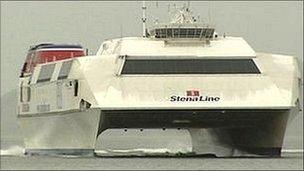End of the line for Stena Voyager
- Published

The Stena Voyager's days are numbered following the huge in crease in fuel prices
It is literally part of the Belfast skyline when it is in port.
The huge futuristic shape of the HSS Stena Voyager ferry was easily recognisable from several miles away.
On the ferry route between Belfast and Scotland its wedge shape is unique.
But its days are numbered.
The HSS (High Speed Service) design was the world's biggest high speed ferry.
Its space-age shape and Star Trek-style bridge was only matched by the fact that the name of one of the captains really was Captain Kirk.
With its high speed and quick turnaround it quickly became a favourite with passengers.
But as time would prove, it had two Achilles heels. One was its limited freight capacity while the other was the cost of running it.
Only three were ever built. Powered by massive gas turbine engines, its powerful water jets could push this vast aluminium catamaran along at 40 knots.
Two HSS ran services across the Irish Sea; between Belfast and Stranraer in Scotland and between Dun Laoghaire near Dublin and Holyhead in Wales.
When the HSS started operating in 1996, oil was just $18 a barrel.
Today's prices, close to a $100, have changed the equation.
In an attempt to reduce fuel costs, the ferry reduced its cruising speed.
Inevitably the journey took longer and this created an opportunity for the opposition.
It meant that conventional ships could cross the Irish Sea faster than the HSS, albeit on a different and shorter route from Larne.
They were cheaper to run and had good freight capacity. The writing was on the bulkhead for the HSS.
The final nail in the HSS Voyager coffin was the decision by its owners to move its Scottish port of operation from Stranraer, at the bottom of Loch Ryan on the west coast, to the top of the loch beside the existing port of Cairnryan.
It will save 20 minutes on the journey and means that modern conventional ships can make the crossing almost as quickly as the HSS.
And it was quickly apparent that the new port has no facility for the HSS to dock.
The HSS was always forced to run at a slow speed when in enclosed waters because of the huge wash it created.
The slow run down Belfast Lough to the open sea, and an equally slow run down Loch Ryan at the other end of the voyage, stole much of its thunder.
So, in mid-November the HSS Voyager will make its last trip across the Irish Sea.
More freight
Replacing it will be two fairly modern but conventional ships which will be the biggest ferries ever to sail the route.
And Stena say they will be able to make the crossing in 2 hours and 15 minutes. That is close to the HSS crossing time but using a lot less fuel and carrying a lot more freight.
The freight business is important for any ferry company on the Irish Sea.
It's a significant source of revenue and provides an all-year-round income.
The second HSS on the Irish Sea route, between Dublin and Wales, will also stop service in mid-September.
Stena say it will return again next year for the summer trade. It's not economical to operate it during the winter because it can carry so little freight.
The third HSS, which Stena used to operate on the Harwich-Holland run, is now in La Guaira in Venezuela.
The HSS Voyager will be missed on the Irish Sea.
Its spacious open layout with multi-restaurant and bar facilities proved popular with passengers but the ship could no longer pay its way.
Its fuel-hungry high speed ability was ultimately to become the cause of its demise.
But is it, perhaps more worryingly, a sign of what is to come as the oil price creeps ever upwards?